Reward and Appraisal Management Report: IPRP and Appraisal Systems
VerifiedAdded on 2020/01/28
|21
|4653
|60
Report
AI Summary
This report presents a critical evaluation of individual performance related pay (IPRP) and appraisal systems within the context of performance management in organizations, specifically the NHS. The executive summary highlights the effectiveness and shortcomings of IPRP, explores alternative reward programs, and examines high-performance work organizations. Coursework 1 delves into reward management, assessing the impact of IPRP on performance and identifying potential barriers to its implementation. Coursework 2 analyzes the design, implementation, and impact of high-performance work organizations and the role of appraisal in evaluating individual performance. The report discusses the advantages and disadvantages of IPRP, ways to improve organizational performance through IPRP, and the suitability of IPRP to the business environment. It also identifies barriers to the effective design and implementation of IPRP schemes, offering insights into how these systems can be synthesized into a high-performance work system.

Name:
Date:
Institution:
1 | P a g e
Date:
Institution:
1 | P a g e
Paraphrase This Document
Need a fresh take? Get an instant paraphrase of this document with our AI Paraphraser
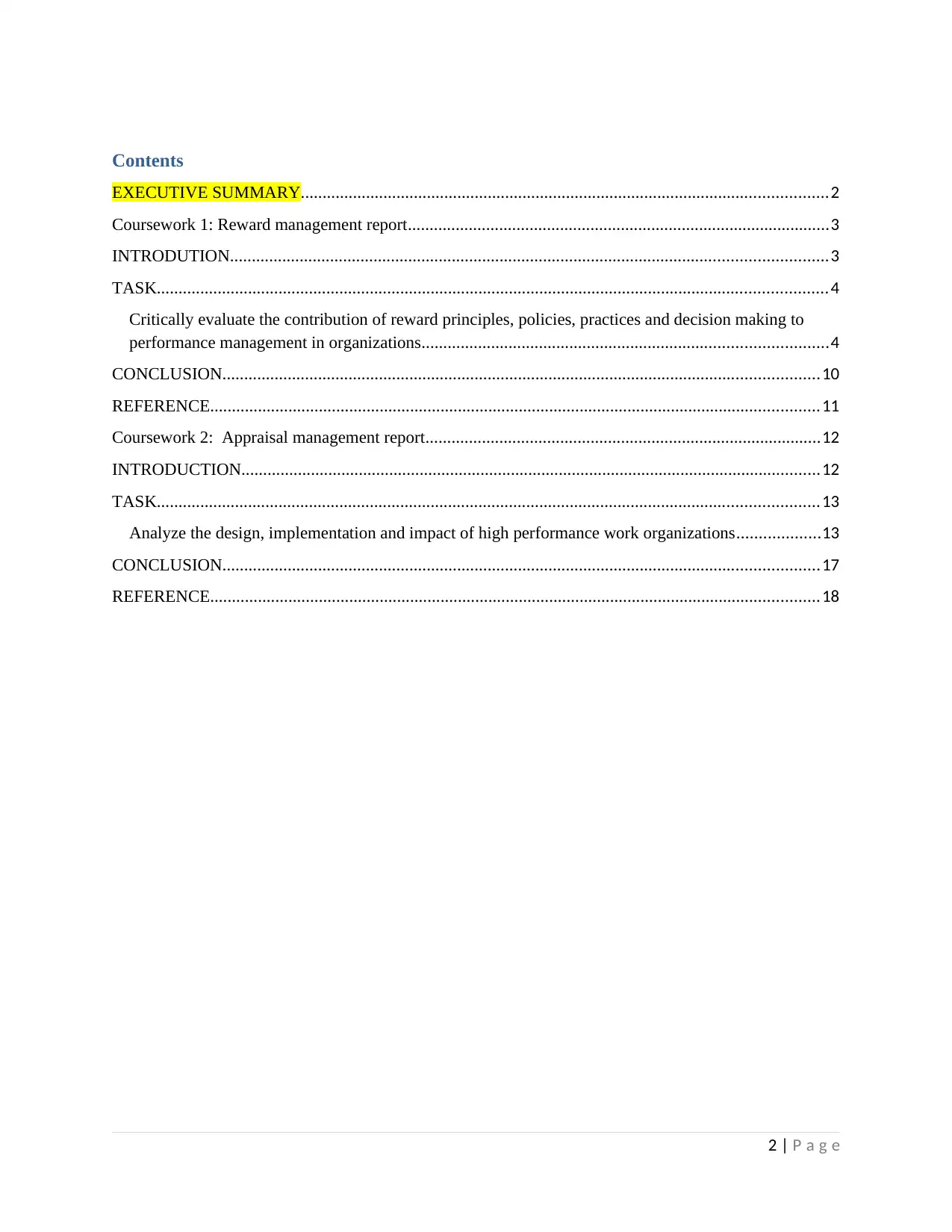
Contents
EXECUTIVE SUMMARY.........................................................................................................................2
Coursework 1: Reward management report.................................................................................................3
INTRODUTION.........................................................................................................................................3
TASK..........................................................................................................................................................4
Critically evaluate the contribution of reward principles, policies, practices and decision making to
performance management in organizations.............................................................................................4
CONCLUSION.........................................................................................................................................10
REFERENCE............................................................................................................................................11
Coursework 2: Appraisal management report...........................................................................................12
INTRODUCTION.....................................................................................................................................12
TASK........................................................................................................................................................13
Analyze the design, implementation and impact of high performance work organizations...................13
CONCLUSION.........................................................................................................................................17
REFERENCE............................................................................................................................................18
2 | P a g e
EXECUTIVE SUMMARY.........................................................................................................................2
Coursework 1: Reward management report.................................................................................................3
INTRODUTION.........................................................................................................................................3
TASK..........................................................................................................................................................4
Critically evaluate the contribution of reward principles, policies, practices and decision making to
performance management in organizations.............................................................................................4
CONCLUSION.........................................................................................................................................10
REFERENCE............................................................................................................................................11
Coursework 2: Appraisal management report...........................................................................................12
INTRODUCTION.....................................................................................................................................12
TASK........................................................................................................................................................13
Analyze the design, implementation and impact of high performance work organizations...................13
CONCLUSION.........................................................................................................................................17
REFERENCE............................................................................................................................................18
2 | P a g e
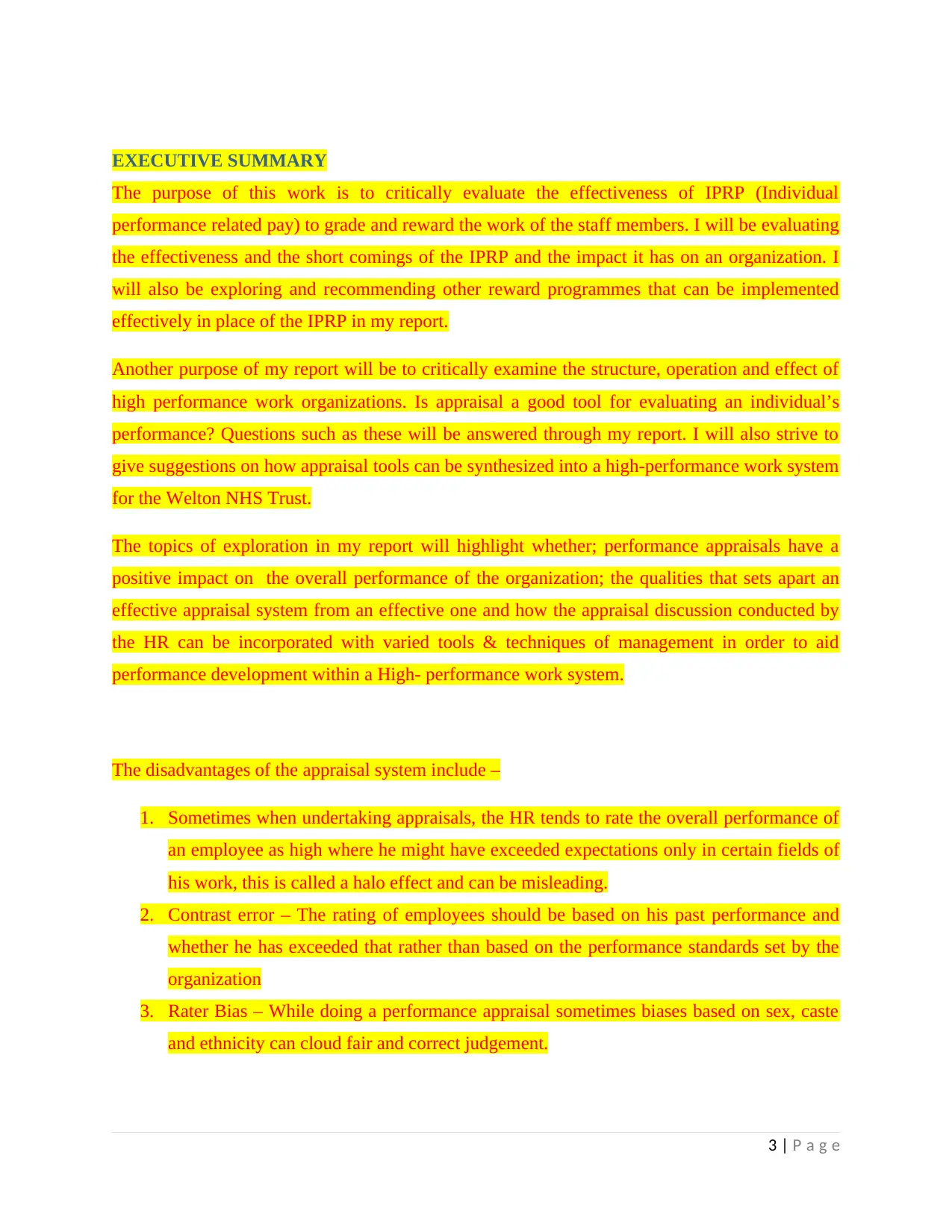
EXECUTIVE SUMMARY
The purpose of this work is to critically evaluate the effectiveness of IPRP (Individual
performance related pay) to grade and reward the work of the staff members. I will be evaluating
the effectiveness and the short comings of the IPRP and the impact it has on an organization. I
will also be exploring and recommending other reward programmes that can be implemented
effectively in place of the IPRP in my report.
Another purpose of my report will be to critically examine the structure, operation and effect of
high performance work organizations. Is appraisal a good tool for evaluating an individual’s
performance? Questions such as these will be answered through my report. I will also strive to
give suggestions on how appraisal tools can be synthesized into a high-performance work system
for the Welton NHS Trust.
The topics of exploration in my report will highlight whether; performance appraisals have a
positive impact on the overall performance of the organization; the qualities that sets apart an
effective appraisal system from an effective one and how the appraisal discussion conducted by
the HR can be incorporated with varied tools & techniques of management in order to aid
performance development within a High- performance work system.
The disadvantages of the appraisal system include –
1. Sometimes when undertaking appraisals, the HR tends to rate the overall performance of
an employee as high where he might have exceeded expectations only in certain fields of
his work, this is called a halo effect and can be misleading.
2. Contrast error – The rating of employees should be based on his past performance and
whether he has exceeded that rather than based on the performance standards set by the
organization
3. Rater Bias – While doing a performance appraisal sometimes biases based on sex, caste
and ethnicity can cloud fair and correct judgement.
3 | P a g e
The purpose of this work is to critically evaluate the effectiveness of IPRP (Individual
performance related pay) to grade and reward the work of the staff members. I will be evaluating
the effectiveness and the short comings of the IPRP and the impact it has on an organization. I
will also be exploring and recommending other reward programmes that can be implemented
effectively in place of the IPRP in my report.
Another purpose of my report will be to critically examine the structure, operation and effect of
high performance work organizations. Is appraisal a good tool for evaluating an individual’s
performance? Questions such as these will be answered through my report. I will also strive to
give suggestions on how appraisal tools can be synthesized into a high-performance work system
for the Welton NHS Trust.
The topics of exploration in my report will highlight whether; performance appraisals have a
positive impact on the overall performance of the organization; the qualities that sets apart an
effective appraisal system from an effective one and how the appraisal discussion conducted by
the HR can be incorporated with varied tools & techniques of management in order to aid
performance development within a High- performance work system.
The disadvantages of the appraisal system include –
1. Sometimes when undertaking appraisals, the HR tends to rate the overall performance of
an employee as high where he might have exceeded expectations only in certain fields of
his work, this is called a halo effect and can be misleading.
2. Contrast error – The rating of employees should be based on his past performance and
whether he has exceeded that rather than based on the performance standards set by the
organization
3. Rater Bias – While doing a performance appraisal sometimes biases based on sex, caste
and ethnicity can cloud fair and correct judgement.
3 | P a g e
⊘ This is a preview!⊘
Do you want full access?
Subscribe today to unlock all pages.

Trusted by 1+ million students worldwide
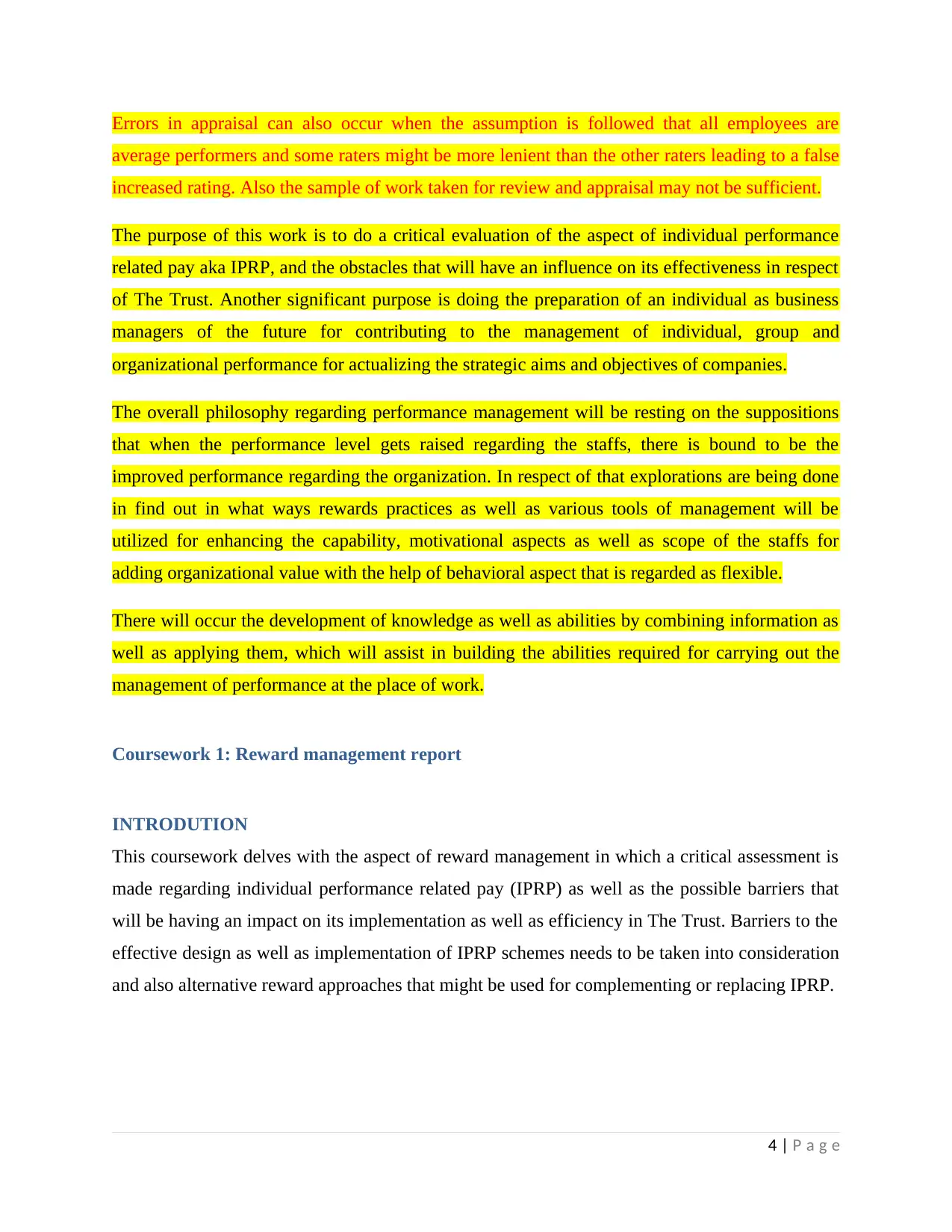
Errors in appraisal can also occur when the assumption is followed that all employees are
average performers and some raters might be more lenient than the other raters leading to a false
increased rating. Also the sample of work taken for review and appraisal may not be sufficient.
The purpose of this work is to do a critical evaluation of the aspect of individual performance
related pay aka IPRP, and the obstacles that will have an influence on its effectiveness in respect
of The Trust. Another significant purpose is doing the preparation of an individual as business
managers of the future for contributing to the management of individual, group and
organizational performance for actualizing the strategic aims and objectives of companies.
The overall philosophy regarding performance management will be resting on the suppositions
that when the performance level gets raised regarding the staffs, there is bound to be the
improved performance regarding the organization. In respect of that explorations are being done
in find out in what ways rewards practices as well as various tools of management will be
utilized for enhancing the capability, motivational aspects as well as scope of the staffs for
adding organizational value with the help of behavioral aspect that is regarded as flexible.
There will occur the development of knowledge as well as abilities by combining information as
well as applying them, which will assist in building the abilities required for carrying out the
management of performance at the place of work.
Coursework 1: Reward management report
INTRODUTION
This coursework delves with the aspect of reward management in which a critical assessment is
made regarding individual performance related pay (IPRP) as well as the possible barriers that
will be having an impact on its implementation as well as efficiency in The Trust. Barriers to the
effective design as well as implementation of IPRP schemes needs to be taken into consideration
and also alternative reward approaches that might be used for complementing or replacing IPRP.
4 | P a g e
average performers and some raters might be more lenient than the other raters leading to a false
increased rating. Also the sample of work taken for review and appraisal may not be sufficient.
The purpose of this work is to do a critical evaluation of the aspect of individual performance
related pay aka IPRP, and the obstacles that will have an influence on its effectiveness in respect
of The Trust. Another significant purpose is doing the preparation of an individual as business
managers of the future for contributing to the management of individual, group and
organizational performance for actualizing the strategic aims and objectives of companies.
The overall philosophy regarding performance management will be resting on the suppositions
that when the performance level gets raised regarding the staffs, there is bound to be the
improved performance regarding the organization. In respect of that explorations are being done
in find out in what ways rewards practices as well as various tools of management will be
utilized for enhancing the capability, motivational aspects as well as scope of the staffs for
adding organizational value with the help of behavioral aspect that is regarded as flexible.
There will occur the development of knowledge as well as abilities by combining information as
well as applying them, which will assist in building the abilities required for carrying out the
management of performance at the place of work.
Coursework 1: Reward management report
INTRODUTION
This coursework delves with the aspect of reward management in which a critical assessment is
made regarding individual performance related pay (IPRP) as well as the possible barriers that
will be having an impact on its implementation as well as efficiency in The Trust. Barriers to the
effective design as well as implementation of IPRP schemes needs to be taken into consideration
and also alternative reward approaches that might be used for complementing or replacing IPRP.
4 | P a g e
Paraphrase This Document
Need a fresh take? Get an instant paraphrase of this document with our AI Paraphraser
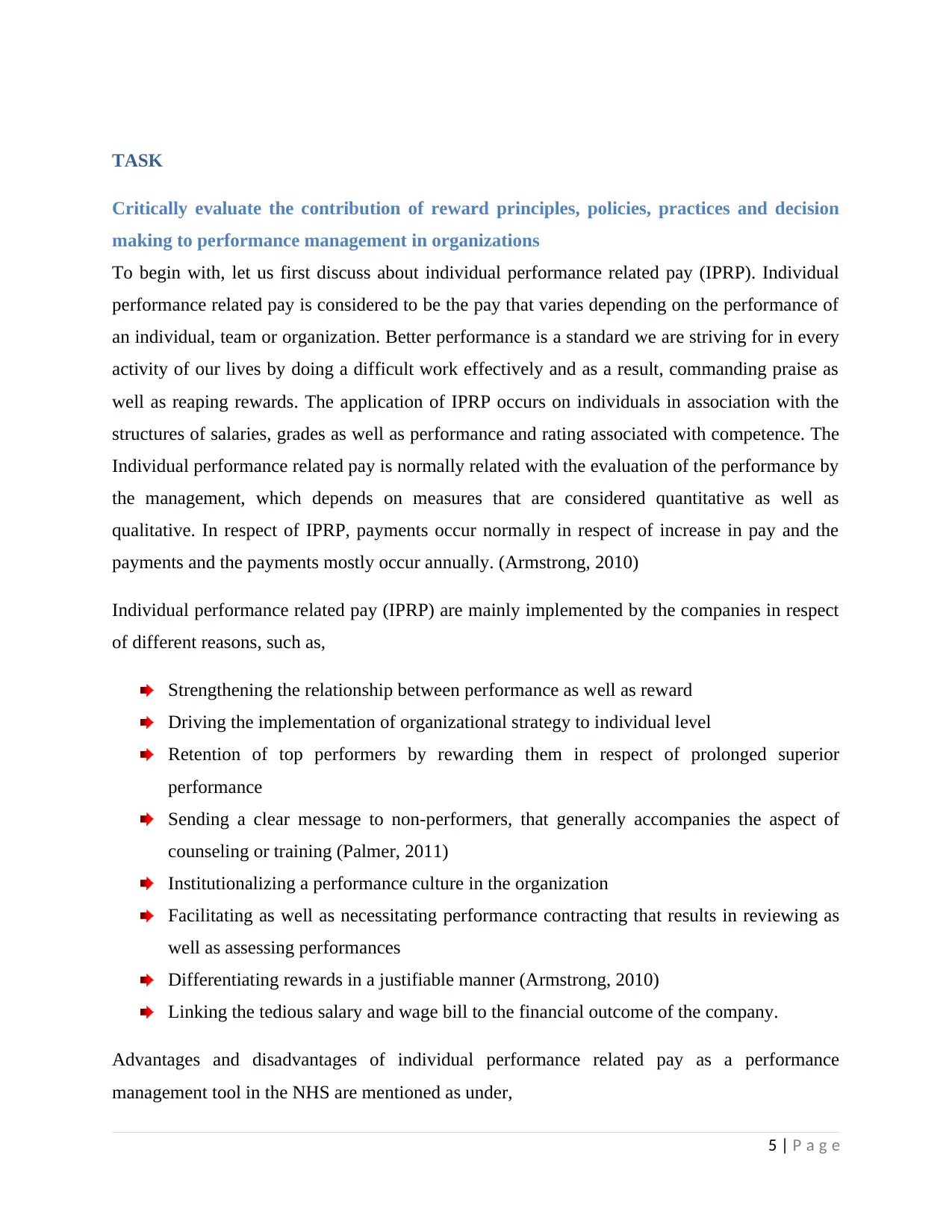
TASK
Critically evaluate the contribution of reward principles, policies, practices and decision
making to performance management in organizations
To begin with, let us first discuss about individual performance related pay (IPRP). Individual
performance related pay is considered to be the pay that varies depending on the performance of
an individual, team or organization. Better performance is a standard we are striving for in every
activity of our lives by doing a difficult work effectively and as a result, commanding praise as
well as reaping rewards. The application of IPRP occurs on individuals in association with the
structures of salaries, grades as well as performance and rating associated with competence. The
Individual performance related pay is normally related with the evaluation of the performance by
the management, which depends on measures that are considered quantitative as well as
qualitative. In respect of IPRP, payments occur normally in respect of increase in pay and the
payments and the payments mostly occur annually. (Armstrong, 2010)
Individual performance related pay (IPRP) are mainly implemented by the companies in respect
of different reasons, such as,
Strengthening the relationship between performance as well as reward
Driving the implementation of organizational strategy to individual level
Retention of top performers by rewarding them in respect of prolonged superior
performance
Sending a clear message to non-performers, that generally accompanies the aspect of
counseling or training (Palmer, 2011)
Institutionalizing a performance culture in the organization
Facilitating as well as necessitating performance contracting that results in reviewing as
well as assessing performances
Differentiating rewards in a justifiable manner (Armstrong, 2010)
Linking the tedious salary and wage bill to the financial outcome of the company.
Advantages and disadvantages of individual performance related pay as a performance
management tool in the NHS are mentioned as under,
5 | P a g e
Critically evaluate the contribution of reward principles, policies, practices and decision
making to performance management in organizations
To begin with, let us first discuss about individual performance related pay (IPRP). Individual
performance related pay is considered to be the pay that varies depending on the performance of
an individual, team or organization. Better performance is a standard we are striving for in every
activity of our lives by doing a difficult work effectively and as a result, commanding praise as
well as reaping rewards. The application of IPRP occurs on individuals in association with the
structures of salaries, grades as well as performance and rating associated with competence. The
Individual performance related pay is normally related with the evaluation of the performance by
the management, which depends on measures that are considered quantitative as well as
qualitative. In respect of IPRP, payments occur normally in respect of increase in pay and the
payments and the payments mostly occur annually. (Armstrong, 2010)
Individual performance related pay (IPRP) are mainly implemented by the companies in respect
of different reasons, such as,
Strengthening the relationship between performance as well as reward
Driving the implementation of organizational strategy to individual level
Retention of top performers by rewarding them in respect of prolonged superior
performance
Sending a clear message to non-performers, that generally accompanies the aspect of
counseling or training (Palmer, 2011)
Institutionalizing a performance culture in the organization
Facilitating as well as necessitating performance contracting that results in reviewing as
well as assessing performances
Differentiating rewards in a justifiable manner (Armstrong, 2010)
Linking the tedious salary and wage bill to the financial outcome of the company.
Advantages and disadvantages of individual performance related pay as a performance
management tool in the NHS are mentioned as under,
5 | P a g e
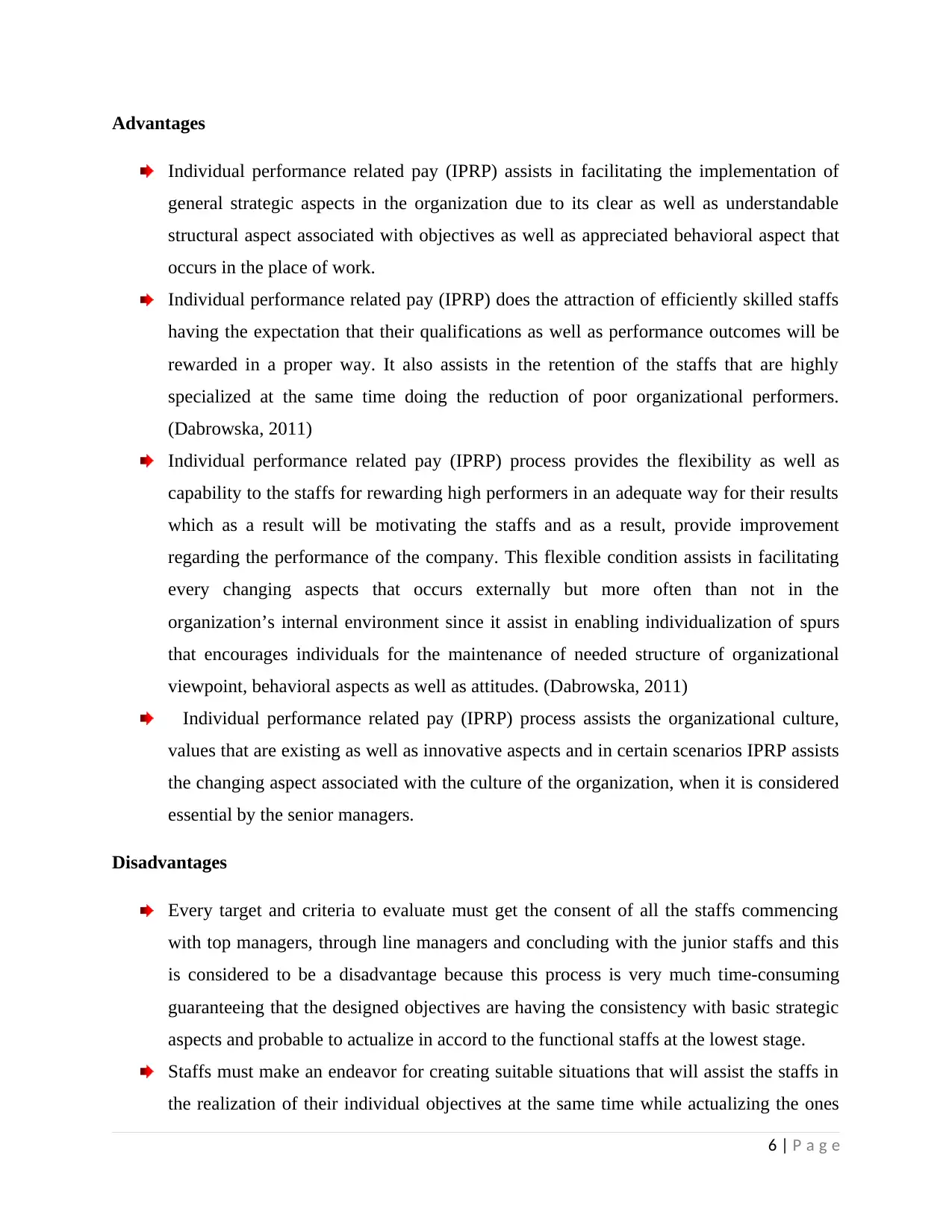
Advantages
Individual performance related pay (IPRP) assists in facilitating the implementation of
general strategic aspects in the organization due to its clear as well as understandable
structural aspect associated with objectives as well as appreciated behavioral aspect that
occurs in the place of work.
Individual performance related pay (IPRP) does the attraction of efficiently skilled staffs
having the expectation that their qualifications as well as performance outcomes will be
rewarded in a proper way. It also assists in the retention of the staffs that are highly
specialized at the same time doing the reduction of poor organizational performers.
(Dabrowska, 2011)
Individual performance related pay (IPRP) process provides the flexibility as well as
capability to the staffs for rewarding high performers in an adequate way for their results
which as a result will be motivating the staffs and as a result, provide improvement
regarding the performance of the company. This flexible condition assists in facilitating
every changing aspects that occurs externally but more often than not in the
organization’s internal environment since it assist in enabling individualization of spurs
that encourages individuals for the maintenance of needed structure of organizational
viewpoint, behavioral aspects as well as attitudes. (Dabrowska, 2011)
Individual performance related pay (IPRP) process assists the organizational culture,
values that are existing as well as innovative aspects and in certain scenarios IPRP assists
the changing aspect associated with the culture of the organization, when it is considered
essential by the senior managers.
Disadvantages
Every target and criteria to evaluate must get the consent of all the staffs commencing
with top managers, through line managers and concluding with the junior staffs and this
is considered to be a disadvantage because this process is very much time-consuming
guaranteeing that the designed objectives are having the consistency with basic strategic
aspects and probable to actualize in accord to the functional staffs at the lowest stage.
Staffs must make an endeavor for creating suitable situations that will assist the staffs in
the realization of their individual objectives at the same time while actualizing the ones
6 | P a g e
Individual performance related pay (IPRP) assists in facilitating the implementation of
general strategic aspects in the organization due to its clear as well as understandable
structural aspect associated with objectives as well as appreciated behavioral aspect that
occurs in the place of work.
Individual performance related pay (IPRP) does the attraction of efficiently skilled staffs
having the expectation that their qualifications as well as performance outcomes will be
rewarded in a proper way. It also assists in the retention of the staffs that are highly
specialized at the same time doing the reduction of poor organizational performers.
(Dabrowska, 2011)
Individual performance related pay (IPRP) process provides the flexibility as well as
capability to the staffs for rewarding high performers in an adequate way for their results
which as a result will be motivating the staffs and as a result, provide improvement
regarding the performance of the company. This flexible condition assists in facilitating
every changing aspects that occurs externally but more often than not in the
organization’s internal environment since it assist in enabling individualization of spurs
that encourages individuals for the maintenance of needed structure of organizational
viewpoint, behavioral aspects as well as attitudes. (Dabrowska, 2011)
Individual performance related pay (IPRP) process assists the organizational culture,
values that are existing as well as innovative aspects and in certain scenarios IPRP assists
the changing aspect associated with the culture of the organization, when it is considered
essential by the senior managers.
Disadvantages
Every target and criteria to evaluate must get the consent of all the staffs commencing
with top managers, through line managers and concluding with the junior staffs and this
is considered to be a disadvantage because this process is very much time-consuming
guaranteeing that the designed objectives are having the consistency with basic strategic
aspects and probable to actualize in accord to the functional staffs at the lowest stage.
Staffs must make an endeavor for creating suitable situations that will assist the staffs in
the realization of their individual objectives at the same time while actualizing the ones
6 | P a g e
⊘ This is a preview!⊘
Do you want full access?
Subscribe today to unlock all pages.

Trusted by 1+ million students worldwide
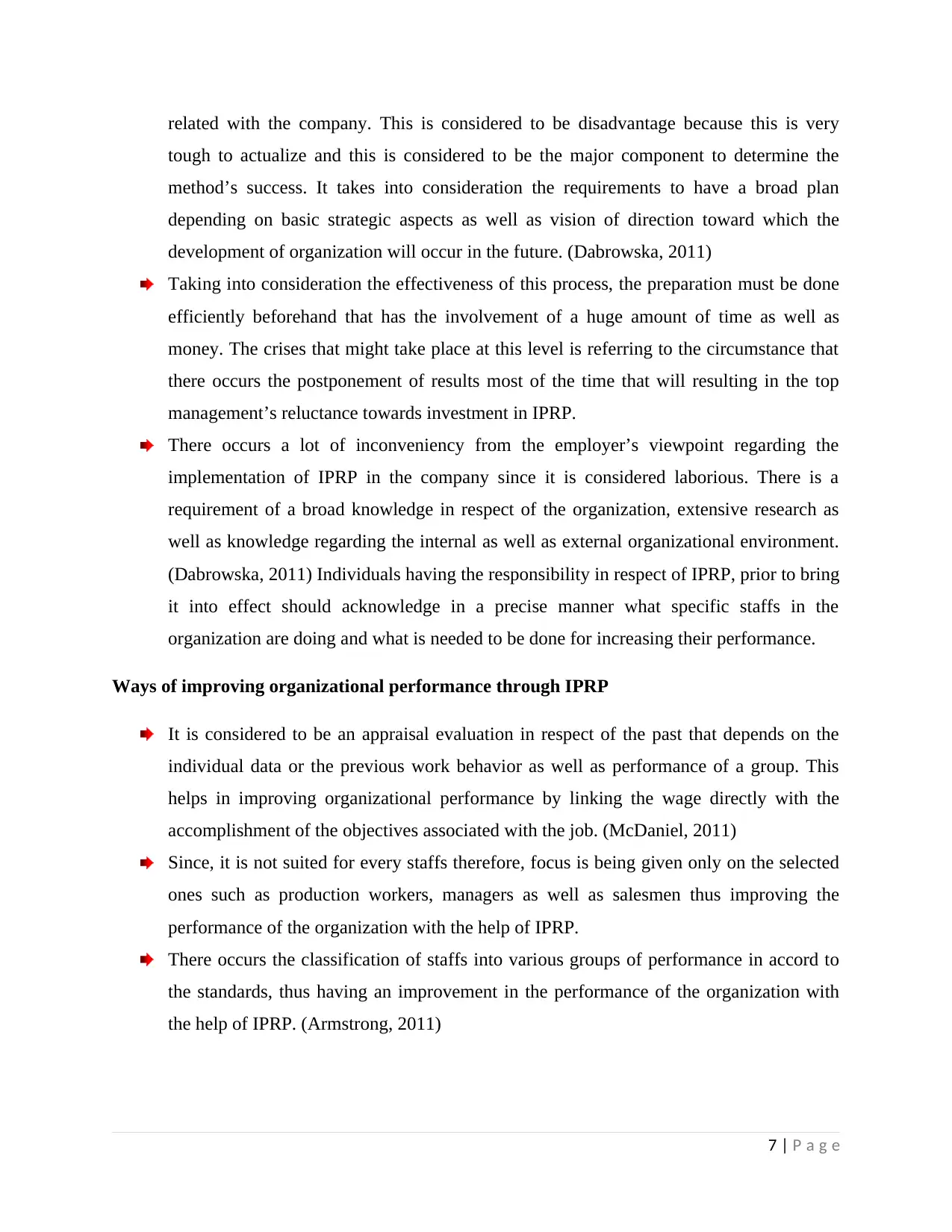
related with the company. This is considered to be disadvantage because this is very
tough to actualize and this is considered to be the major component to determine the
method’s success. It takes into consideration the requirements to have a broad plan
depending on basic strategic aspects as well as vision of direction toward which the
development of organization will occur in the future. (Dabrowska, 2011)
Taking into consideration the effectiveness of this process, the preparation must be done
efficiently beforehand that has the involvement of a huge amount of time as well as
money. The crises that might take place at this level is referring to the circumstance that
there occurs the postponement of results most of the time that will resulting in the top
management’s reluctance towards investment in IPRP.
There occurs a lot of inconveniency from the employer’s viewpoint regarding the
implementation of IPRP in the company since it is considered laborious. There is a
requirement of a broad knowledge in respect of the organization, extensive research as
well as knowledge regarding the internal as well as external organizational environment.
(Dabrowska, 2011) Individuals having the responsibility in respect of IPRP, prior to bring
it into effect should acknowledge in a precise manner what specific staffs in the
organization are doing and what is needed to be done for increasing their performance.
Ways of improving organizational performance through IPRP
It is considered to be an appraisal evaluation in respect of the past that depends on the
individual data or the previous work behavior as well as performance of a group. This
helps in improving organizational performance by linking the wage directly with the
accomplishment of the objectives associated with the job. (McDaniel, 2011)
Since, it is not suited for every staffs therefore, focus is being given only on the selected
ones such as production workers, managers as well as salesmen thus improving the
performance of the organization with the help of IPRP.
There occurs the classification of staffs into various groups of performance in accord to
the standards, thus having an improvement in the performance of the organization with
the help of IPRP. (Armstrong, 2011)
7 | P a g e
tough to actualize and this is considered to be the major component to determine the
method’s success. It takes into consideration the requirements to have a broad plan
depending on basic strategic aspects as well as vision of direction toward which the
development of organization will occur in the future. (Dabrowska, 2011)
Taking into consideration the effectiveness of this process, the preparation must be done
efficiently beforehand that has the involvement of a huge amount of time as well as
money. The crises that might take place at this level is referring to the circumstance that
there occurs the postponement of results most of the time that will resulting in the top
management’s reluctance towards investment in IPRP.
There occurs a lot of inconveniency from the employer’s viewpoint regarding the
implementation of IPRP in the company since it is considered laborious. There is a
requirement of a broad knowledge in respect of the organization, extensive research as
well as knowledge regarding the internal as well as external organizational environment.
(Dabrowska, 2011) Individuals having the responsibility in respect of IPRP, prior to bring
it into effect should acknowledge in a precise manner what specific staffs in the
organization are doing and what is needed to be done for increasing their performance.
Ways of improving organizational performance through IPRP
It is considered to be an appraisal evaluation in respect of the past that depends on the
individual data or the previous work behavior as well as performance of a group. This
helps in improving organizational performance by linking the wage directly with the
accomplishment of the objectives associated with the job. (McDaniel, 2011)
Since, it is not suited for every staffs therefore, focus is being given only on the selected
ones such as production workers, managers as well as salesmen thus improving the
performance of the organization with the help of IPRP.
There occurs the classification of staffs into various groups of performance in accord to
the standards, thus having an improvement in the performance of the organization with
the help of IPRP. (Armstrong, 2011)
7 | P a g e
Paraphrase This Document
Need a fresh take? Get an instant paraphrase of this document with our AI Paraphraser
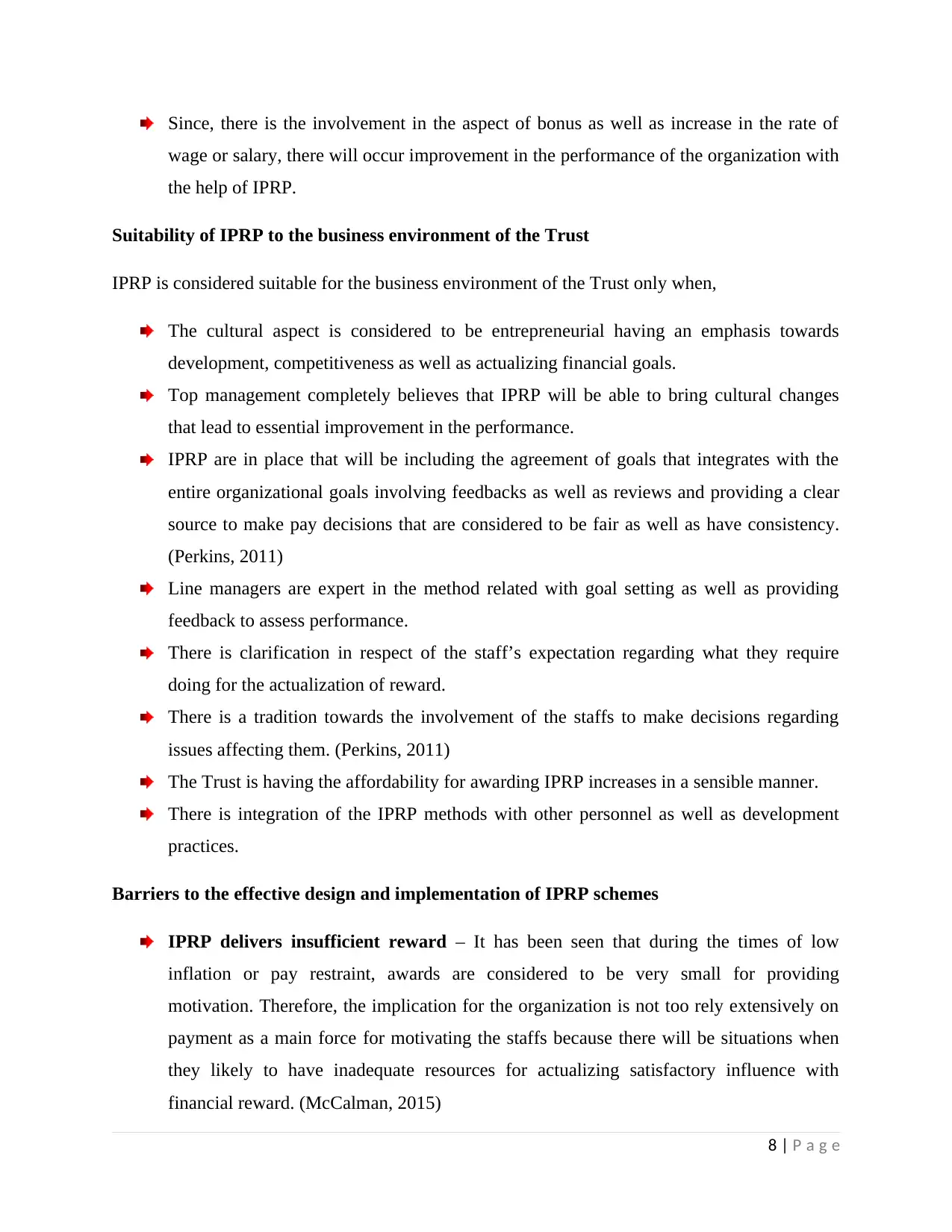
Since, there is the involvement in the aspect of bonus as well as increase in the rate of
wage or salary, there will occur improvement in the performance of the organization with
the help of IPRP.
Suitability of IPRP to the business environment of the Trust
IPRP is considered suitable for the business environment of the Trust only when,
The cultural aspect is considered to be entrepreneurial having an emphasis towards
development, competitiveness as well as actualizing financial goals.
Top management completely believes that IPRP will be able to bring cultural changes
that lead to essential improvement in the performance.
IPRP are in place that will be including the agreement of goals that integrates with the
entire organizational goals involving feedbacks as well as reviews and providing a clear
source to make pay decisions that are considered to be fair as well as have consistency.
(Perkins, 2011)
Line managers are expert in the method related with goal setting as well as providing
feedback to assess performance.
There is clarification in respect of the staff’s expectation regarding what they require
doing for the actualization of reward.
There is a tradition towards the involvement of the staffs to make decisions regarding
issues affecting them. (Perkins, 2011)
The Trust is having the affordability for awarding IPRP increases in a sensible manner.
There is integration of the IPRP methods with other personnel as well as development
practices.
Barriers to the effective design and implementation of IPRP schemes
IPRP delivers insufficient reward – It has been seen that during the times of low
inflation or pay restraint, awards are considered to be very small for providing
motivation. Therefore, the implication for the organization is not too rely extensively on
payment as a main force for motivating the staffs because there will be situations when
they likely to have inadequate resources for actualizing satisfactory influence with
financial reward. (McCalman, 2015)
8 | P a g e
wage or salary, there will occur improvement in the performance of the organization with
the help of IPRP.
Suitability of IPRP to the business environment of the Trust
IPRP is considered suitable for the business environment of the Trust only when,
The cultural aspect is considered to be entrepreneurial having an emphasis towards
development, competitiveness as well as actualizing financial goals.
Top management completely believes that IPRP will be able to bring cultural changes
that lead to essential improvement in the performance.
IPRP are in place that will be including the agreement of goals that integrates with the
entire organizational goals involving feedbacks as well as reviews and providing a clear
source to make pay decisions that are considered to be fair as well as have consistency.
(Perkins, 2011)
Line managers are expert in the method related with goal setting as well as providing
feedback to assess performance.
There is clarification in respect of the staff’s expectation regarding what they require
doing for the actualization of reward.
There is a tradition towards the involvement of the staffs to make decisions regarding
issues affecting them. (Perkins, 2011)
The Trust is having the affordability for awarding IPRP increases in a sensible manner.
There is integration of the IPRP methods with other personnel as well as development
practices.
Barriers to the effective design and implementation of IPRP schemes
IPRP delivers insufficient reward – It has been seen that during the times of low
inflation or pay restraint, awards are considered to be very small for providing
motivation. Therefore, the implication for the organization is not too rely extensively on
payment as a main force for motivating the staffs because there will be situations when
they likely to have inadequate resources for actualizing satisfactory influence with
financial reward. (McCalman, 2015)
8 | P a g e
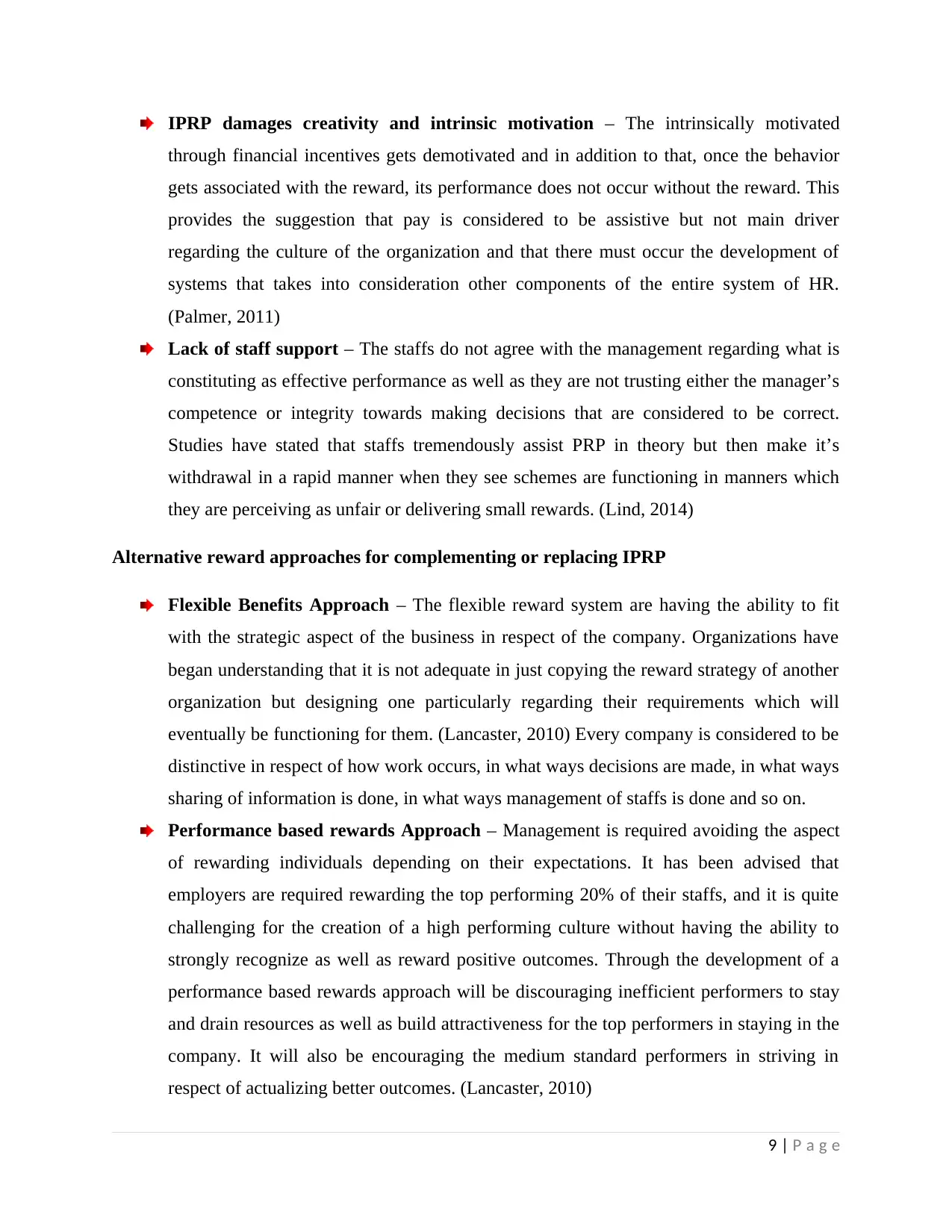
IPRP damages creativity and intrinsic motivation – The intrinsically motivated
through financial incentives gets demotivated and in addition to that, once the behavior
gets associated with the reward, its performance does not occur without the reward. This
provides the suggestion that pay is considered to be assistive but not main driver
regarding the culture of the organization and that there must occur the development of
systems that takes into consideration other components of the entire system of HR.
(Palmer, 2011)
Lack of staff support – The staffs do not agree with the management regarding what is
constituting as effective performance as well as they are not trusting either the manager’s
competence or integrity towards making decisions that are considered to be correct.
Studies have stated that staffs tremendously assist PRP in theory but then make it’s
withdrawal in a rapid manner when they see schemes are functioning in manners which
they are perceiving as unfair or delivering small rewards. (Lind, 2014)
Alternative reward approaches for complementing or replacing IPRP
Flexible Benefits Approach – The flexible reward system are having the ability to fit
with the strategic aspect of the business in respect of the company. Organizations have
began understanding that it is not adequate in just copying the reward strategy of another
organization but designing one particularly regarding their requirements which will
eventually be functioning for them. (Lancaster, 2010) Every company is considered to be
distinctive in respect of how work occurs, in what ways decisions are made, in what ways
sharing of information is done, in what ways management of staffs is done and so on.
Performance based rewards Approach – Management is required avoiding the aspect
of rewarding individuals depending on their expectations. It has been advised that
employers are required rewarding the top performing 20% of their staffs, and it is quite
challenging for the creation of a high performing culture without having the ability to
strongly recognize as well as reward positive outcomes. Through the development of a
performance based rewards approach will be discouraging inefficient performers to stay
and drain resources as well as build attractiveness for the top performers in staying in the
company. It will also be encouraging the medium standard performers in striving in
respect of actualizing better outcomes. (Lancaster, 2010)
9 | P a g e
through financial incentives gets demotivated and in addition to that, once the behavior
gets associated with the reward, its performance does not occur without the reward. This
provides the suggestion that pay is considered to be assistive but not main driver
regarding the culture of the organization and that there must occur the development of
systems that takes into consideration other components of the entire system of HR.
(Palmer, 2011)
Lack of staff support – The staffs do not agree with the management regarding what is
constituting as effective performance as well as they are not trusting either the manager’s
competence or integrity towards making decisions that are considered to be correct.
Studies have stated that staffs tremendously assist PRP in theory but then make it’s
withdrawal in a rapid manner when they see schemes are functioning in manners which
they are perceiving as unfair or delivering small rewards. (Lind, 2014)
Alternative reward approaches for complementing or replacing IPRP
Flexible Benefits Approach – The flexible reward system are having the ability to fit
with the strategic aspect of the business in respect of the company. Organizations have
began understanding that it is not adequate in just copying the reward strategy of another
organization but designing one particularly regarding their requirements which will
eventually be functioning for them. (Lancaster, 2010) Every company is considered to be
distinctive in respect of how work occurs, in what ways decisions are made, in what ways
sharing of information is done, in what ways management of staffs is done and so on.
Performance based rewards Approach – Management is required avoiding the aspect
of rewarding individuals depending on their expectations. It has been advised that
employers are required rewarding the top performing 20% of their staffs, and it is quite
challenging for the creation of a high performing culture without having the ability to
strongly recognize as well as reward positive outcomes. Through the development of a
performance based rewards approach will be discouraging inefficient performers to stay
and drain resources as well as build attractiveness for the top performers in staying in the
company. It will also be encouraging the medium standard performers in striving in
respect of actualizing better outcomes. (Lancaster, 2010)
9 | P a g e
⊘ This is a preview!⊘
Do you want full access?
Subscribe today to unlock all pages.

Trusted by 1+ million students worldwide
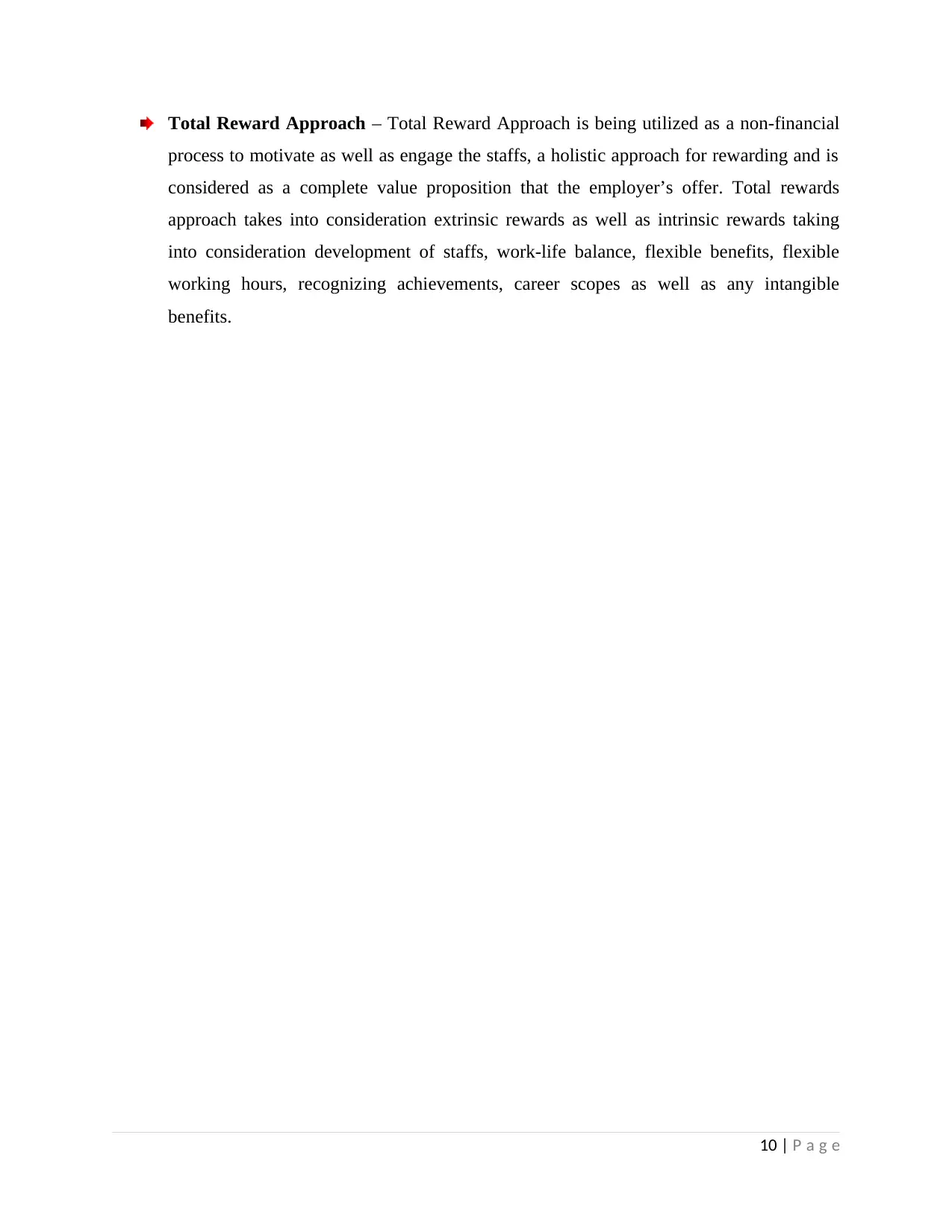
Total Reward Approach – Total Reward Approach is being utilized as a non-financial
process to motivate as well as engage the staffs, a holistic approach for rewarding and is
considered as a complete value proposition that the employer’s offer. Total rewards
approach takes into consideration extrinsic rewards as well as intrinsic rewards taking
into consideration development of staffs, work-life balance, flexible benefits, flexible
working hours, recognizing achievements, career scopes as well as any intangible
benefits.
10 | P a g e
process to motivate as well as engage the staffs, a holistic approach for rewarding and is
considered as a complete value proposition that the employer’s offer. Total rewards
approach takes into consideration extrinsic rewards as well as intrinsic rewards taking
into consideration development of staffs, work-life balance, flexible benefits, flexible
working hours, recognizing achievements, career scopes as well as any intangible
benefits.
10 | P a g e
Paraphrase This Document
Need a fresh take? Get an instant paraphrase of this document with our AI Paraphraser
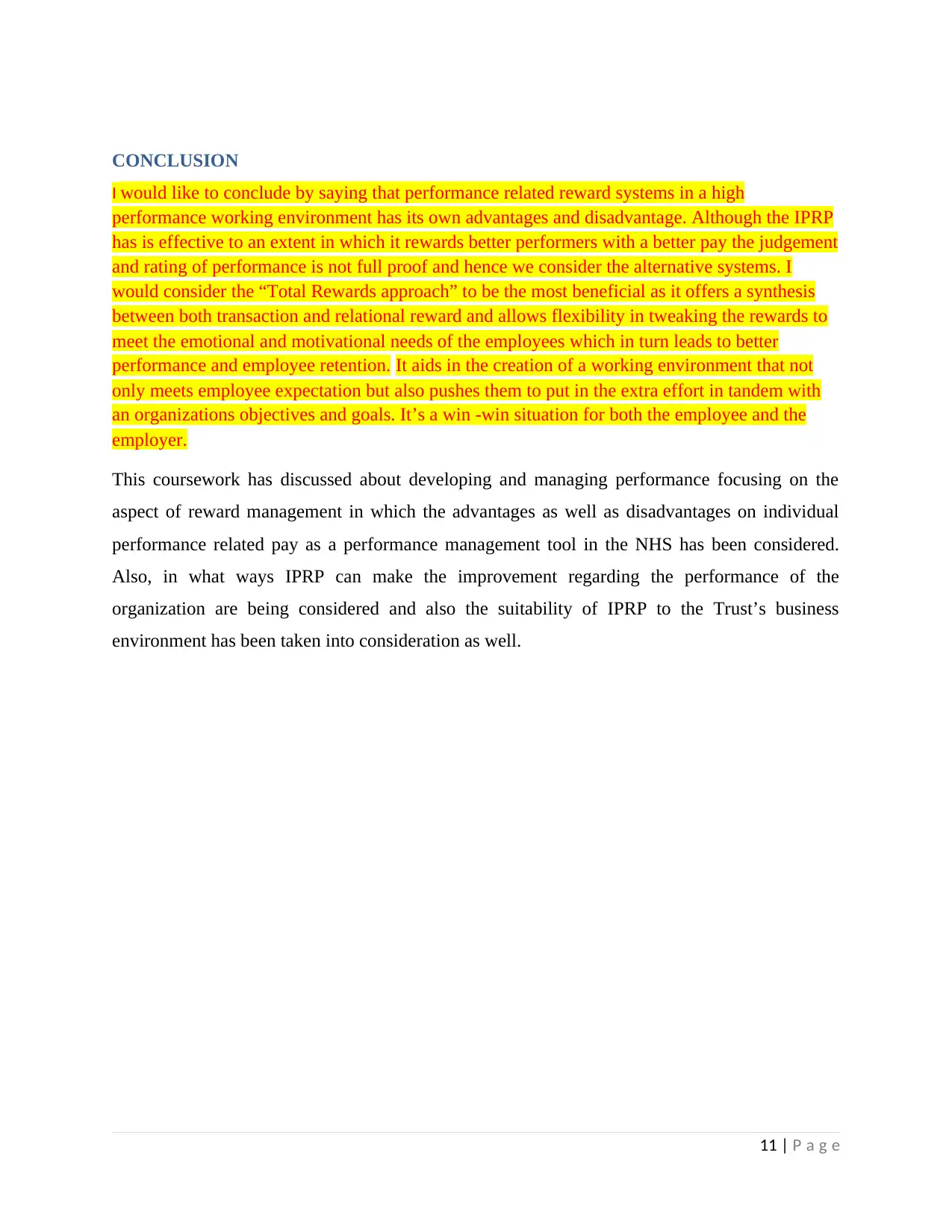
CONCLUSION
I would like to conclude by saying that performance related reward systems in a high
performance working environment has its own advantages and disadvantage. Although the IPRP
has is effective to an extent in which it rewards better performers with a better pay the judgement
and rating of performance is not full proof and hence we consider the alternative systems. I
would consider the “Total Rewards approach” to be the most beneficial as it offers a synthesis
between both transaction and relational reward and allows flexibility in tweaking the rewards to
meet the emotional and motivational needs of the employees which in turn leads to better
performance and employee retention. It aids in the creation of a working environment that not
only meets employee expectation but also pushes them to put in the extra effort in tandem with
an organizations objectives and goals. It’s a win -win situation for both the employee and the
employer.
This coursework has discussed about developing and managing performance focusing on the
aspect of reward management in which the advantages as well as disadvantages on individual
performance related pay as a performance management tool in the NHS has been considered.
Also, in what ways IPRP can make the improvement regarding the performance of the
organization are being considered and also the suitability of IPRP to the Trust’s business
environment has been taken into consideration as well.
11 | P a g e
I would like to conclude by saying that performance related reward systems in a high
performance working environment has its own advantages and disadvantage. Although the IPRP
has is effective to an extent in which it rewards better performers with a better pay the judgement
and rating of performance is not full proof and hence we consider the alternative systems. I
would consider the “Total Rewards approach” to be the most beneficial as it offers a synthesis
between both transaction and relational reward and allows flexibility in tweaking the rewards to
meet the emotional and motivational needs of the employees which in turn leads to better
performance and employee retention. It aids in the creation of a working environment that not
only meets employee expectation but also pushes them to put in the extra effort in tandem with
an organizations objectives and goals. It’s a win -win situation for both the employee and the
employer.
This coursework has discussed about developing and managing performance focusing on the
aspect of reward management in which the advantages as well as disadvantages on individual
performance related pay as a performance management tool in the NHS has been considered.
Also, in what ways IPRP can make the improvement regarding the performance of the
organization are being considered and also the suitability of IPRP to the Trust’s business
environment has been taken into consideration as well.
11 | P a g e
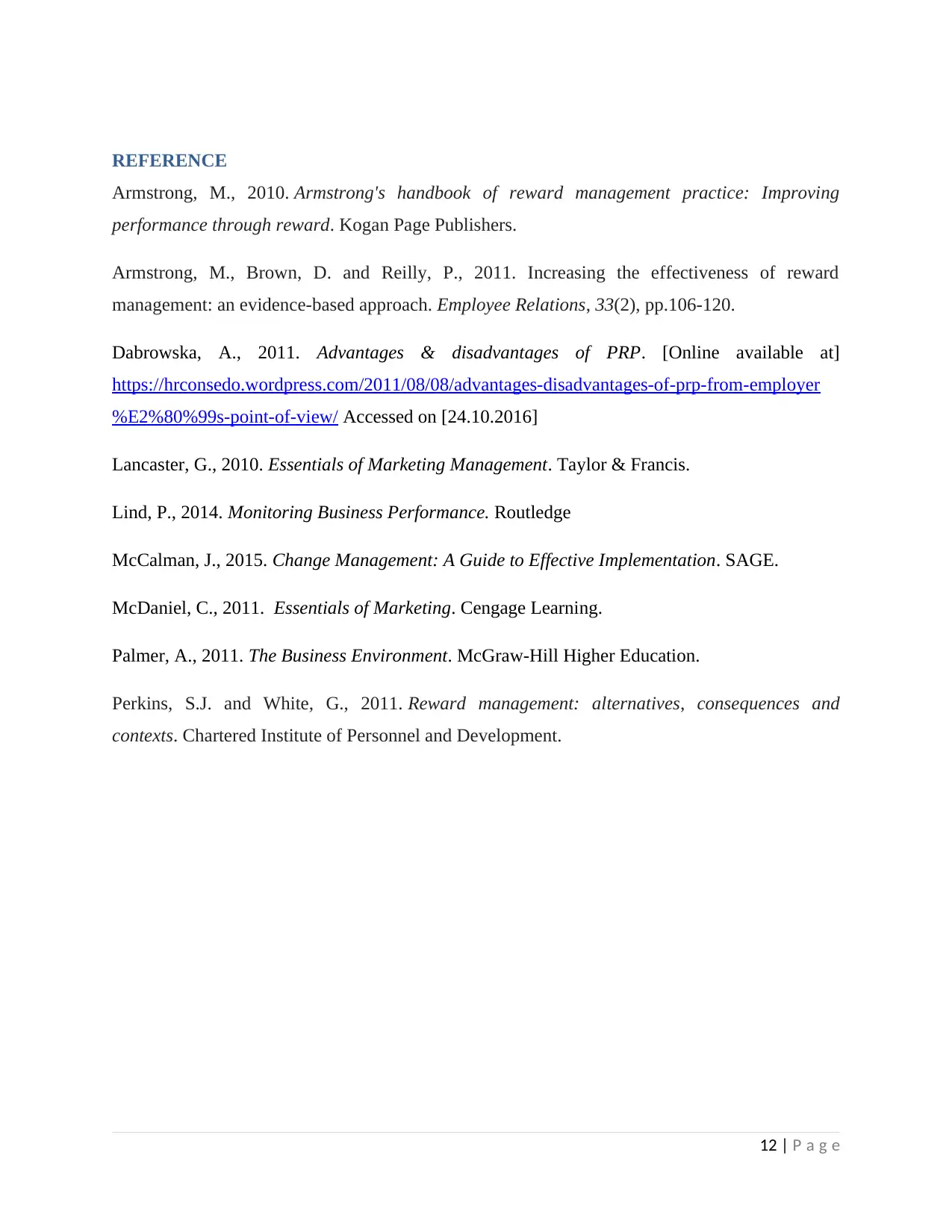
REFERENCE
Armstrong, M., 2010. Armstrong's handbook of reward management practice: Improving
performance through reward. Kogan Page Publishers.
Armstrong, M., Brown, D. and Reilly, P., 2011. Increasing the effectiveness of reward
management: an evidence-based approach. Employee Relations, 33(2), pp.106-120.
Dabrowska, A., 2011. Advantages & disadvantages of PRP. [Online available at]
https://hrconsedo.wordpress.com/2011/08/08/advantages-disadvantages-of-prp-from-employer
%E2%80%99s-point-of-view/ Accessed on [24.10.2016]
Lancaster, G., 2010. Essentials of Marketing Management. Taylor & Francis.
Lind, P., 2014. Monitoring Business Performance. Routledge
McCalman, J., 2015. Change Management: A Guide to Effective Implementation. SAGE.
McDaniel, C., 2011. Essentials of Marketing. Cengage Learning.
Palmer, A., 2011. The Business Environment. McGraw-Hill Higher Education.
Perkins, S.J. and White, G., 2011. Reward management: alternatives, consequences and
contexts. Chartered Institute of Personnel and Development.
12 | P a g e
Armstrong, M., 2010. Armstrong's handbook of reward management practice: Improving
performance through reward. Kogan Page Publishers.
Armstrong, M., Brown, D. and Reilly, P., 2011. Increasing the effectiveness of reward
management: an evidence-based approach. Employee Relations, 33(2), pp.106-120.
Dabrowska, A., 2011. Advantages & disadvantages of PRP. [Online available at]
https://hrconsedo.wordpress.com/2011/08/08/advantages-disadvantages-of-prp-from-employer
%E2%80%99s-point-of-view/ Accessed on [24.10.2016]
Lancaster, G., 2010. Essentials of Marketing Management. Taylor & Francis.
Lind, P., 2014. Monitoring Business Performance. Routledge
McCalman, J., 2015. Change Management: A Guide to Effective Implementation. SAGE.
McDaniel, C., 2011. Essentials of Marketing. Cengage Learning.
Palmer, A., 2011. The Business Environment. McGraw-Hill Higher Education.
Perkins, S.J. and White, G., 2011. Reward management: alternatives, consequences and
contexts. Chartered Institute of Personnel and Development.
12 | P a g e
⊘ This is a preview!⊘
Do you want full access?
Subscribe today to unlock all pages.

Trusted by 1+ million students worldwide
1 out of 21
Related Documents
Your All-in-One AI-Powered Toolkit for Academic Success.
+13062052269
info@desklib.com
Available 24*7 on WhatsApp / Email
![[object Object]](/_next/static/media/star-bottom.7253800d.svg)
Unlock your academic potential
Copyright © 2020–2025 A2Z Services. All Rights Reserved. Developed and managed by ZUCOL.




